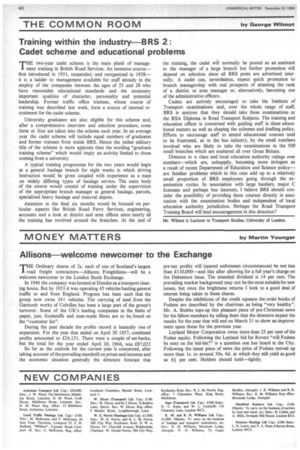THE COMMON ROOM by George Wilmot
Page 42

If you've noticed an error in this article please click here to report it so we can fix it.
Training within the industry---BRS 2: Cadet scheme and educational problems
THE two-year cadet scheme is the main plank of manage,
ment training in British Road Services. An intensive course— first introduced in 1951, suspended, and reorganized in 1958— it is a ladder to management available for staff already in the employ of the companies between the ages of 23 and 28 who have reasonable educational standards and the necessary important qualities of character, personality and potential leadership. Former traffic office trainees, whose course of training was described last week, form a source of internal recruitment for the cadet scheme.
University graduates are also eligible for this scheme and, after a comprehensive interview and selection procedure, some three or four are taken into the scheme each year. In an average year the cadet scheme will include equal numbers of graduates and former trainees from inside BRS. Hence the rather military title of the scheme is more apposite than the wording "graduate training scheme" which would imply an activity limited to those coming from a university.
A typical training programme for the two years would begin at a general haulage branch for eight weeks in which driving instruction would be given coupled with experience as a mate on widely differing types of haulage service. The main body of the course would consist of training under the supervision of the appropriate branch manager at general haulage, parcels, specialized heavy haulage and removal depots.
Attention in the final six months would be focused on particular aspects like British Road Ferry Services, engineering, accounts and a look at district and area offices since nearly all the training has revolved around the branches. At the end of the training, the cadet will normally be posted as an assistant to the manager of a large branch but further promotion will depend on selection since all BRS posts are advertised internally. A cadet can, nevertheless, expect quick promotion to branch managership with real prospects of attaining the rank of a district or area manager or, alternatively, becoming one of the administrative officers.
Cadets are actively encouraged to take the Institute of Transport examinations and, over the whole range of staff, BRS is anxious that they should take these examinations or the RSA Diploma in Road Transport Subjects. The training and education officer is concerned with guiding staff in these educational matters as well as shaping the schemes and drafting policy. Efforts to encourage staff to attend educational courses tend to be frustrated, as in the bus industry, by the small numbers involved who are likely to take the examinations in the 500 small branches which are scattered all over Great Britain.
Distance to a class and local education authority rulings over numbers--which are, unhappily, becoming more stringent as a result of recent Department of Education and Science policy— are familiar problems which in this case add up to a relatively small proportion of BRS employees going through the examination cycles. In association with large hauliers, major C licensees and perhaps bus interests, I believe BRS should consider the possibility of providing these courses directly in association with the examination bodies and independent of local education authority jurisdiction. Perhaps the Road Transport Training Board will lend encouragement in this direction?
Mr. Wilmot is Lecturer in Transport Studies, University of London.












































































